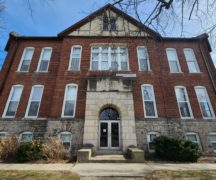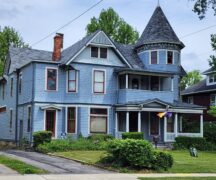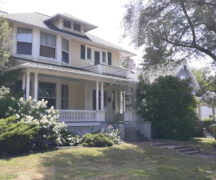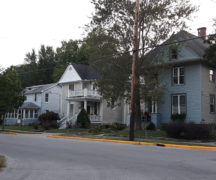(Written by Geoffrey C. Howes, Bowling Green Historic Preservation Commission)
December’s Historic Building of the Month is the tall, handsome Renaissance Revival building in the northwest section of Bowling Green’s Main Street Historic District in the Mercer Block, now better known as the Masonic Temple.
Jackson D. and Fulton M. Mercer had it built in 1903, and the inventory of the National Register of Historic Places calls it the “last of the oil and gas boom buildings in this district.”
It was originally occupied by Fulton Mercer’s furniture store on the first floor and offices on the upper floors. In 1920, the Bowling Green Masonic Lodge purchased it as its headquarters.
The sloping mansard-like roof of the structure at 157-163 North Main Street was originally covered with clay tiles and featured elaborate ornamentation over the three central arched windows, which are flanked by two smaller windows. Although these adornments have been removed from the roof, the bracketed cornice over the third story retains the original ornate design, as do the six pairs of windows on the second and third stories, which are set off by masonry blocks called quoins at the edges of the façade and between the windows. The storefronts at street level have been modernized and the display windows have been reduced in size.
In the Wood County Sentinel of March 17, 1904, the year after the building was erected, an advertisement for F. M. Mercer’s store announces “FURNITURE! If you wish to inspect a complete new line of Furniture consisting of all the latest designs in Bed Room Suites, Dining Tables and Chairs, Parlor Pieces, Couches, Etc. you should visit the new store in the Mercer Block. You will find everything up to date and marked at prices that will not hurt your pocket-book.”
In the same edition there are smaller ads for “Geo. A. Southwick, Refracting Optician, Suite 3, Mercer Block,” “Drs. I. M. & C. O. Schrader, Physicians and Surgeons, Offices in New Mercer Block,” and “Dr. E. J. Frowine, Dentist, Office, New Mercer Block. All Kinds of Dental Work.”
By 1909, Mercer’s furniture store had been replaced by Whitker & Co. Furniture, and to this day the painted sign for Whitker’s Furniture is faintly visible high on the south wall of the building. Sometime before 1930 the store became B. M. Meeker’s Furniture. The “B” in B. M. Meeker stands for “Bessie.”
Bessie Meeker had a partner, Frank W. Haskell, but hers was the name on the sign. By 1947, the store at 157 N. Main St. had become the Lubell Furniture Company, owned by Toledo residents Irving and Samuel Lubell. In 1954, the Wood County Furniture Company is listed at that address, with Roy E. Digby as president, E. Grace Box vice president, and John Box secretary-treasurer.
By 1974, Robert H. Sears and his wife and partner Mary Jo Sears had taken over the store, adding “RHS Decorating” to its name. In 1975 they added “Furniture Fashions”; in 1980, “Accent Interiors” had replaced “Wood County Furniture.”
After 85 years as a furniture store, in 1988 it became a location of the Blue Ribbon Photo chain. Blue Ribbon went out of business in 2003, but an employee, Charlie Peckinpaugh, bought the store and renamed it Studio 157. The operations manager at Studio 157, Todd Brininger, purchased the store in 2009 and called it Main Street Photo. In 2020 Main Street Photo moved to its present West Wooster Street location.
Get Inspired Nutrition now occupies the space at 157 N. Main St. At 163 N. Main St., the commercial space on the ground floor that now houses the Loonar Station, spent much of its existence as a restaurant. The 1937 city directory lists a restaurant there owned by Gayle B. and Gertrude M. Houser, which later became Muirs Restaurant, then the Main Restaurant.
By 1961 it was Arline’s Beauty Salon, owned by Arline Rohrs. The 1993 directory shows the Bowling Green Chamber of Commerce at 163 N. Main St., where it stayed until 2019, variously sharing the space with the Private Industry Council, the Convention and Visitors Bureau, and the WFOB radio station.
In 1910, the prominent attorneys Elmer G. McClelland and Shadrach W. Bowman opened their practice at 161 N. Main St., the second floor of the Mercer Block. McClelland was the Wood County prosecuting attorney for six years, ran for Congress in 1906, and was a presidential elector in 1908. In 1914 he was elected judge of the Common Pleas Court. Bowman had been superintendent of Milton Center and Haskins schools, Wood County recorder, and mayor of Bowling Green. In 1931 he became president of the newly formed Wood County Bank at 130 South Main Street. He maintained his office into the 1950s, partnering with Martin L. Hanna and Lelan S. Middleton, who was also the city solicitor. Shadrach Bowman’s wife Mayme was an abstractor of title in the same office. Bowman, Hanna & Middleton later became Middleton & Roebke, then Middleton, Roebke & Woessner.
The history of the Masonic Lodge in Wood County began many years before the 1920 purchase of the building at 159 N. Main St. In the summer of 1842, area Masons met on a farm near what is now the intersection of River Road and Ohio 582. The new association then occupied the second floor of a log house northwest of Tontogany, and its first meeting of record was held on June 7, 1843.
The lodge was granted its charter on Oct. 20, 1843. The lodge moved in 1849 to a home on Napoleon Road in Bowling Green, and in 1854 to the hotel at Main and Wooster. From 1870-1892, the lodge met on the third floor of the Rogers Block at 135 N. Main St. (now housing Tubby’s Tavern), and in 1894 they moved to the third floor of the Cunning and Whitehead building at 117 N. Main St. (where Kalifornia Glow is now). In 1920, the Bowling Green Masonic Temple Company was organized, and on March 3 it purchased its present quarters for $30,000 (about $470,000 in today’s dollars). The second, third, and fourth floors were remodeled with the help of Langdon and Ohly Architects of Toledo while maintaining the original wood accents, tin ceilings, and lighting fixtures.
The Masonic clubroom and library are on the second floor, the Grand Temple meeting room is on the third floor, and the fourth floor is a dining room. The building has a basement, which is rare for downtown. Five Masonic organizations now occupy the upper floors: the Wood County Lodge No. 112, Free & Accepted Masons (chartered 1843), the Crystal Chapter No. 157, Royal Arch Masons (chartered 1889), Greenwood Chapter No. 159, Order of the Eastern Star (chartered 1903), Bowling Green Council No. 124, Royal & Selected Masons (chartered 1920), and the Bowling Green Chapter of the Order of DeMolay (chartered 1923).
The Masonic Lodge not only preserves its own traditions, but it also contributes significantly to preserving the substance of the Main Street Historic District.
(Dale Arnold, member of the Masonic Lodge and friend of the Historic Preservation Commission, assisted in gathering information for this article.)
Would you like to nominate a historic building or site for recognition? You can do this through the city website at – https://www.bgohio.org/FormCenter/Planning-13/Historic-BuildingSite-Nomination-Form-83
You can learn more about the Historic Preservation Commission by attending the meetings (the fourth Tuesday of each month at 4 p.m.) or by visiting the webpage at -https://www.bgohio.org/436/Historic-Preservation-Commission.





